‘Maybe the Only Way to Have an Answer to the Unknown Is to Face It Every So Often’
The first time I went whitewater rafting, my river guide was a scraggly hippie whose response to every topic, from butterfly sightings to tornado warnings, was, “No worries.” This was the spring of 2005. I was 25 and four years into a professional career; he was about the same age and taking his sixth consecutive semester off to find himself. Before our group plopped into individual inflatable kayaks, our dashing and potentially doped-out guide gave us a set of instructions from on high, like a doctor passing out free heart attacks: “The No. 1 cause of death out here is people getting their foot stuck in rocks and drowning when the river pulls them under,” he said. “The only thing you can hope for then is that your leg snaps and you break free. So if you take a spill, don’t try to stand up. All right? No worries.”
A few hours into the trip, we encountered a set of falls named Fat Lady Squeeze and my boat capsized. My shin rapped against the rocks below the surface. I flipped over on my back to let my life jacket take the wheel and float me downstream, only to see a reel of whitecaps tumbling toward me. I kicked my feet above the surface to make sure they were still there. But I wasn’t moving. I was stuck on something while freshwater from the mountaintop rushed over me, into my mouth, up my nose and across my eyes, and as I looked toward the sky and imagined my obituary—Michael Nevitt Graff, 25, died Saturday inside Fat Lady Squeeze—I heard a voice from a shadowy figure standing on a nearby rock.
“Hey, man. Stand up, man.”
“But you said…”
“Yeah, man, but it’s only like a foot deep there. Just stand up.”
I stood up, looked around, and sank under the laughs from the group.
“Thanks,” I said.
“No worries.”
Eleven springtimes later, another creek, another mountain. Here I am again, flailing in rushing water. Only this time, I don’t have an inflatable kayak, just a giant pack on my back, a camera around my neck, a map and compass in the pockets of my new $100 waterproof pants, and a thousand or so Clif Bars stuffed in any available space. It’s a Saturday in mid-April, and I’m three hours into a two-day overnight hike in Joyce Kilmer-Slickrock Wilderness, one of the last remaining pieces of virgin forest in the eastern U.S. It’s 17,400 acres of woods unblemished by anything but time and a few narrow paths, where more hikers have gotten lost than any other place in North Carolina.
The jagged Slickrock Creek Trail, named one of the eight most challenging hikes in the country by Men’s Fitness, is a 13.3-mile route that starts at the foot of a winding road nicknamed the Tail of the Dragon, famous among Harley enthusiasts and people who drive those little zoom-zoom cars that sound like dirt bikes. From there the trail hops back and forth over Slickrock Creek, which forms part of the border between North Carolina and Tennessee. After a dozen creek crossings, the trail angles skyward, eventually dumping hikers onto the 4,800-foot-high saddle named Naked Ground Gap. My goal is to conquer it today, camp at Naked Ground, then hook up with another trail that takes a less-strenuous 8.5-mile route back. A little more than 22 miles in two days; out and up and back and home. Simple—or so I thought.
Four miles in, I find myself halfway across the creek, water up to my waist, my left foot in North Carolina and my right foot in Tennessee, going down. Turns out the rocks in Slickrock Creek are very slick, and my hiking shoes have slipped in opposite directions. What I’m trying to say is that I’m a 36-year-old man who, for the first time in his life, is doing the splits. In rushing water. In the middle of a virgin forest that’s shielded itself from man for centuries. With nobody downstream to laugh at me. With no guide on the rocks to advise me. With no human being within at least 4 miles of me. With lots of worries.
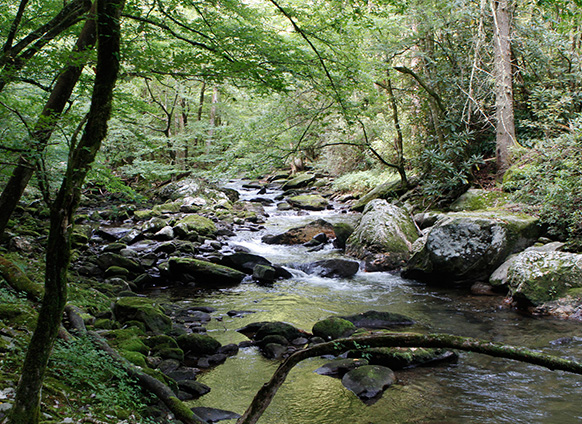
CLAY DUDA
The only voices I hear are in my head, from my more experienced hiking friends, who told me over and over during the week leading up to this trip that I should not, under any circumstance other than a considered and chosen death, attempt this hike alone.
***
I live in what most real estate agents would say is a leafy neighborhood, about a half a mile outside uptown Charlotte, North Carolina. In the summer I can sit on my front porch and listen to the chirp of blackbirds and the song of sparrows, and in the winter, when the leaves have fallen, I can see the top of the 48-story Duke Energy Building, home of the nation’s largest electric holding company.
Every day the local newspaper lands on my porch, at most 5 feet from the door. But if I decide it requires too much effort to step outside and pick it up, an electronic edition is already in my email. And if the e-edition is too much effort, the same newspaper sends another email called the Daily Headlines Edition. And if that’s too much effort, the same newspaper sends another email newsletter that’s geared toward a younger audience, and the majority of this last newsletter is a simplified version of Daily Headlines Edition, which is a simplified version of the e-edition, which is a simplified version of the newspaper. And if none of that information is convenient enough, there’s another newsletter in the city started by a former newspaper employee who now competes with the newspaper and all of its newsletters. Trying to keep up with it all is a little like walking through a flea market where everybody’s selling “Top 7 Outdoor Porches with Views of Nature and the City You MUST Try Right Now,” all of which pale in comparison to my front porch, where the newspaper sits.
That’s just one segment of local news. It doesn’t include television. It doesn’t include national news. It doesn’t include marketing campaigns, friends’ social media updates and all of the other components of a world in which your time is someone else’s commodity, a world in which seemingly everyone is trying to find ways to reach through your phone and into your living room to steal your attention, just for a minute, promise.
“It’s not fair,” my neighbor Vincent likes to say. “All day, we’re bombarded with messages and information and advice. We can’t hide from it.”
Vincent runs ultramarathons to escape it.
About a year ago, I took up day hiking, spending a Saturday morning here and there going up to a mountaintop and back, mostly safe and short hikes on heavily traveled trails. I never camped, certainly not alone. But when I was asked whether I wanted to try one of the most challenging hikes in the country and write about it, I said yes. Just another walk, I thought. On a Tuesday in April, I saw 70 degrees and sunshine in the weekend forecast.
In the three days that followed, I asked friends for advice. The first rule, they all agreed, was to find a hiking partner. Of course they also said they were too busy to go with me. Other advice ranged from what type of gear to bring (a tent and a backpack) to where I’d most likely spot a snake (sunny spots) to what to do when I saw a bear (hope it doesn’t see me).
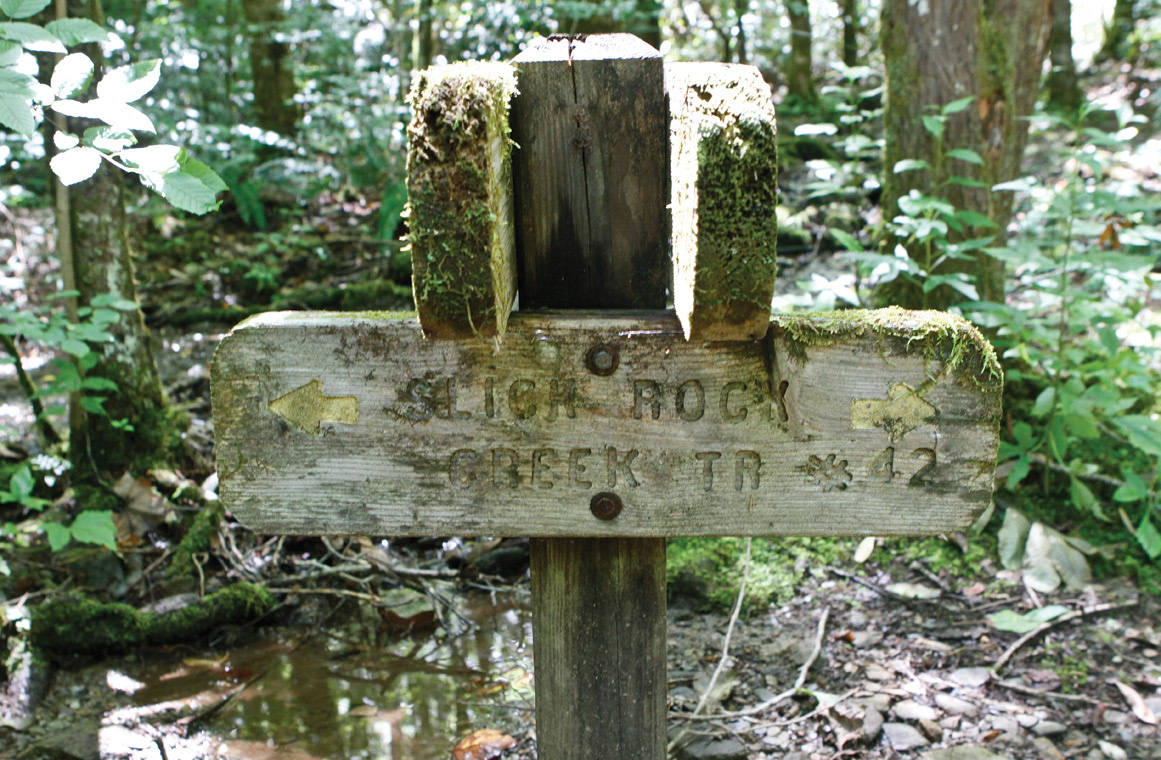
CLAY DUDA
Nobody talked about the views. Nobody talked about the beauty of nature. They told me about first-aid kits and deadly ticks. I called the park ranger’s office. A man named Heath Emmons, whose title is natural resource specialist, read a brief synopsis of the trail to me. “It’s trail No. 42 in our forest trail system. Difficulty is strenuous. Usage is lightly used. Has about 12 creek crossings. Some are easy and some are more challenging. Some are waist deep.” He paused for a second when talking about the water. “We’ve had lots of people go up there and get stuck.”
The night before the hike, I rented a room at a lodge near the trailhead. The lodge has a restaurant with a nice outside patio overlooking a river. As I ate a supreme pizza, I overheard a local man talking to a group of young car enthusiasts who’d come down from Chicago to drive the Tail of the Dragon. I heard the man tell them, “Not a lot of deer in the county. But a lotta bear and a lotta hog.”
After breakfast the next morning, I drove to the trailhead. I shut the truck door at about 9:15 a.m. and started walking. When I got to the sign that marked the start of Slickrock Creek Trail, I turned around and went back. On scrap paper, I wrote a note and left it on the front seat:
“Hiking through Sunday, 4-17-16. If truck is here after that, call 911.”
***
“About a half an hour into the hike now. Just realized I could do this.”
Just like Davy Crockett, I started my walk into the Appalachian wilderness by recording notes on my iPhone. This was much less time-consuming than writing them out, and after listening to the tape a few weeks after the trip, it’s also more embarrassing.
Early on, I jumped when I saw a snail. I was afraid to climb over fallen trees because I was certain snakes hid underneath. I swatted at every fly and sprayed for ticks every half hour or so. And when the trail went down toward waterfalls that most travel brochures would label majestic, I said the following:
“Walking through here, you’re just kind of like, ‘Is there a bear around here?’”
And then, “All those people telling me not to go alone, I’m starting to hear them now. And, uh, just wish I could enjoy it more, as opposed to constantly being reminded that I am possibly stupid.”
I happen to enjoy water and adventure, I should say. I grew up fishing on the Chesapeake Bay on my father’s charter boat, and I’ve jumped out of a plane and written extensively about skydiving. Here near the creek, though, at the base of the V formed by two hard mountains, I couldn’t gaze out at open water; I couldn’t fly through open sky. I couldn’t even see what waited around the next turn.
I crossed Slickrock Creek for the first time at 11:35 a.m., about two hours into the hike. It took me a few minutes to understand the crossing. The trail simply led to the water. On the other side of the creek, about 30 yards away, was a small, wooden sign with a faint inscription, “Slickrock Cr.” I used binoculars to read it.
(In the mid-1970s, scientists published a riveting geological survey of the area, the condensed version of which goes like this: They found a whole lot of sandstone, slate and other rocks dating back to the Precambrian era, more than 500 million years ago. Best I could tell, looking through the clear water, most of what I had to navigate was slate, broken into sections of about 2 or 3 feet across. Imagine taking your kitchen countertop, breaking it into sections, then standing on it in a Jacuzzi filled with cold water.)
On the first crossing, Slickrock Creek rose to about my thighs. But I enjoyed the walk. I took a picture of the sign on the other side, turned around, and smiled proudly as I walked away and pulled out my recording device to mark the moment.
“Kind of feel like you’re into it now,” I said, slipping into the second person for some reason.
***
“Coming around another corner, and again it seems like the trail just runs out. You don’t really know what is happening in some spots.”
The trail hadn’t run out. It had forked a bit back, but I missed the turn because I was looking at butterflies. They were all black and small, fluttering over a campsite where someone had been recently. My eyes saw them down the path to the campsite, hundreds of them, and when I went that way, the trail went the other.
The campsite was along the creek. The previous owners left a Wild Turkey bottle leaned up against two rocks. I walked a little ways past the site and the footpath ran out at the water. I didn’t see a “Slickrock Cr.” sign when I looked across, but I figured it couldn’t hurt to cross.
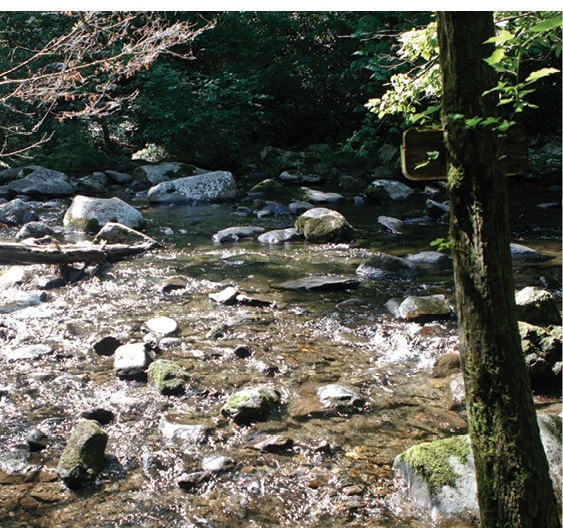
CLAY DUDA
It’s rare in the modern age to do something that nobody else has done before us, but I’d bet good money I was the first person stupid enough to try to cross Slickrock Creek here.
From the splits position with my left foot in North Carolina and my right foot in Tennessee, I had but two ways to fall, forward or backward, and I fell backward. The pack softened the blow. The water was chilly, not cold, but it kept coming, carrying me downstream. There are a few things more dangerous than snakes and bears, I realized then. I kicked my feet above the surface to make sure they were there. I opened and closed my mouth, catching air and water. The ride couldn’t have been more than a dozen feet, but in those few seconds, I became very aware of how this wild place isolated me. It crossed my mind that I could die here and not be found for days.
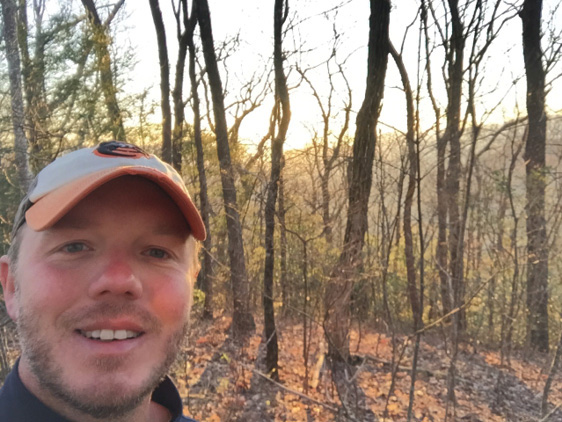
MICHAEL GRAFF
Then the pack smacked a larger rock. I tilted forward and stuffed my feet down. I squatted and pushed up. I slipped again, this time forward, and my knee pounded the rocks. The camera around my neck went underwater. I scrambled again and stood up, water pushing against my thighs, and steadied myself. I plotted a new course. I found one piece of sturdy slate, then another, and eventually the water was at my knees, then my shins, then my ankles, and then I was on the other side.
No more than 10 steps into the North Carolina woods, I realized there was no trail there. I needed to go back to Tennessee. I cursed. I’d just crossed a virgin creek bed on rocks that had gone a billion years undisturbed by humans, rocks that had already rejected my unwelcome shoes once, and I knew I had to tread on them again. I felt like I shouldn’t be here.
A different route. Similar result. This time, the camera around my neck smacked off the ground as I fell forward. My hands slammed against the slate and slid off. I whimpered. I tried to climb to my feet and slipped again and again. Three times. Maybe eight.
I crawled to the edge. I pulled myself onto a dry rock. I sat and slid my hands over my knees. I checked my pockets. A brand-new tumbler I’d purchased—one of those things that promises to keep water cold for centuries—was lost in the stream. Worse, so was my compass.
“I just had a terrible 20 minutes or so,” I told the tape.
***
There’s a restaurant near my house in Charlotte, North Carolina, that scrolls trivia questions on a few television screens all day. Questions about King George III or Snoop Dogg pop up, and multiple-choice answers are presented A through E. You get points for how quickly you choose the correct answer. Anyone in the restaurant can play, simply by downloading an app. Think about that: You select answers to trivia questions using your phone, which is connected to the internet. Who would ever be wrong?
I’ve never seen anyone engaged with the game. Just down the street, though, a new brewery keeps old board games in the back. The other day I saw two young women sitting across the table from each other, holding Trivial Pursuit cards in front of their faces, laughing hysterically at each other’s wrong answers.
In this age of information, there are still times when it’s good to not know everything.
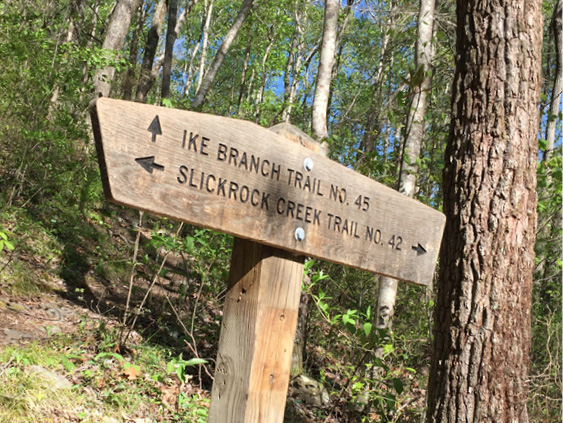
MICHAEL GRAFF
Wet and hungry and tired and late, I walked back, past the butterflies and the ashes, and retraced the trail, until I saw where it forked.
***
North Carolina. Tennessee. North Carolina. Tennessee. North Carolina. I crossed the creek four or five more times when I reached the intersection of Slickrock Creek Trail and Nichols Cove Branch.
This was about 1:45 p.m. I was behind schedule, and I was tired of crossing that creek. On my waterproof map, Nichols Cove Branch appeared to be a fine trail that would cut about a mile or two off the trip before connecting with another trail that connected with Slickrock Creek Trail. Picture a candy cane, and draw a line from one tip to the other, cutting off the curve. That’s basically Nichols Cove Branch.
A half mile or so into Nichols Cove Branch, I lost the trail. I walked back to find it and walked forward again, only to lose it again. This time, I kept going.
Around fifteen minutes later, it was gone for good, and there was no finding my way back, and no sign that anyone had ever been through here. I was in the middle of the wilderness. I looked up at the tops of the poplars, hemlocks and oaks, some of which have been here for hundreds of years. These trees inspired people to give the forest the name Joyce Kilmer, whose most famous poem is named Trees. I unhooked my backpack for the first time all day. I tossed it as far as I could, about a foot or two. I sat on a fallen tree and ate a Clif Bar. It was 3:30 p.m. My first meal of the day. I shouted, “Where’s the trail?”
I cried.
We can’t charge through the wilderness and not expect it to grab us and teach us a lesson about respect. You can believe this or not, but as I sat there tired, hungry and confused, a breeze flipped through the leaves, and the forest seemed to whisper with a million mouths, “Settle down, boy.” I realized I couldn’t shout over the treetops, couldn’t send a tweet from underneath them. I couldn’t be anything, except right there, lost.
***
When I stopped screaming and crying, I heard a stream somewhere. I pulled my pack on and crunched over some leaves and found it, then resolved to walk alongside it until it hit… something. I remembered that my phone had a compass, and turns out, it works even when there’s no cell signal. I headed south-southwest. The map showed more trails this way, and I figured that I’d run into one of them, with any luck.
Eventually, I did. I followed that trail to another trail, and at 4:20 p.m., I saw my first sign in almost three hours. It was the intersection of three trails—Nichols Cove Branch, Benton MacKaye and Windy Gap. I found myself on the map and logged it in my phone.
“There’s nothing worse than not knowing where you are.”
The intersection appeared to be about a half mile from a reunion with Slickrock Creek Trail at the other end of the candy cane. From there, I’d still have 5 to 6 miles to reach Naked Ground. I knew I wouldn’t make it before dark. If I took Windy Gap, though, I’d have about 2 miles to Big Fat Gap. From there, it would be about six miles to the truck tomorrow. I decided to take Windy Gap. I explained myself to my phone.
“The reason I’m going there, as if there needs to be a reason, but, uh, I just want to live. I don’t want to be stranded… It’s funny, I just… It’s funny that I keep talking into a stupid phone. But there’s a lot I want to do. And a stupid risk is stupid.”
***
In the days leading up to the trip, my main fears were bears, snakes and sleeping in the woods alone. When I reached Big Fat Gap just after 6 p.m., I thought about that last part. I imagined something happening to me here in the middle of the night, and I envisioned that obituary again: “Michael Nevitt Graff, 36, survivor of Fat Lady Squeeze, died Saturday at Big Fat Gap.”
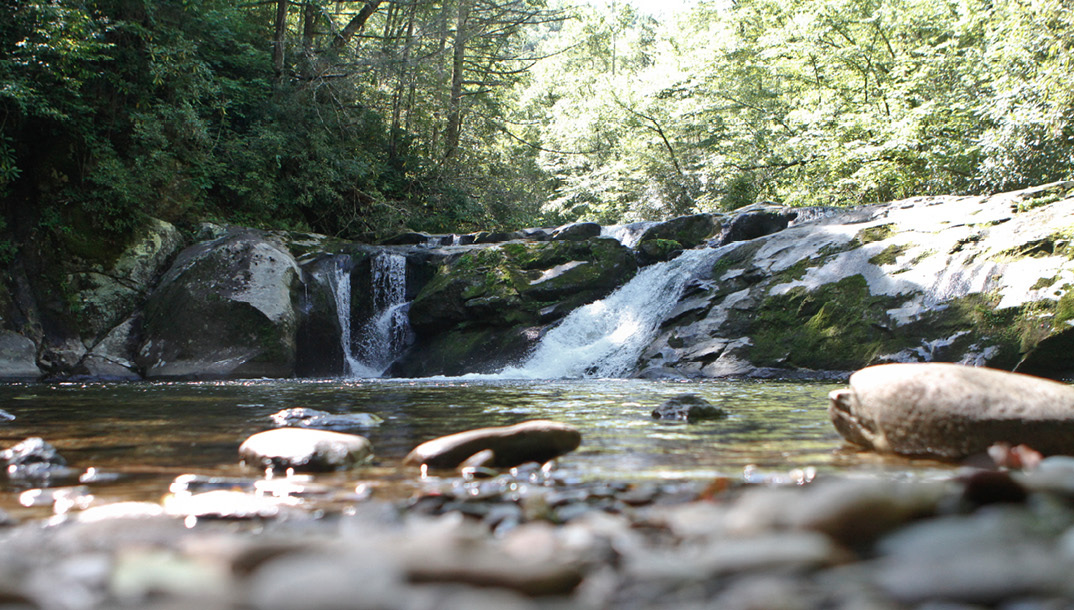
CLAY DUDA
I turned left and followed the trail that would take me home the next morning, Hangover Lead, up to the top of Cold Spring Knob. It wasn’t Naked Ground, but it would do. At about 7 p.m., I arrived at the top of the knob, with views of Tennessee on one side and views of North Carolina on the other, a few thousand feet above the slick slate and whitewater that nearly drowned me. I kicked away some leaves on the southwestern side of the ridge and set up my tent, one stake in the hard ground at a time. I ate trail mix for dinner, and then watched the sun fade over the Tennessee hills. I recorded the colors from top to bottom.
Blue, giving way to a gray, and then a pink and then orange.
When the colors were gone, a half-moon provided enough light to help make it a less-terrifying place, but if I’d learned any lessons by then, it was that there are worse things than the dark. There is, for instance, not knowing where you are. I thought about the people I loved in that tent, thought about how my father now can’t take a single step without his walker, let alone the 31,010 I’d taken that day. I thought about getting home, unsubscribing to those newsletters, and not stressing out about work and emails and living a more purposeful life.
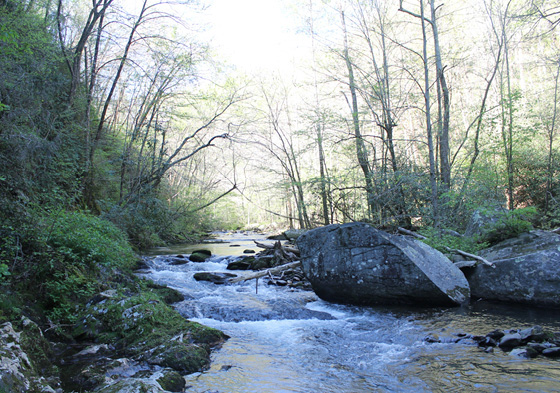
MICHAEL GRAFF
The health app on my phone said that those 31,010 steps added up to 13.32 miles walked and 121 floors climbed in one day. I slept soundly through the night, right there at Cold Spring Knob, elevation 3,490 feet.
“I didn’t make it to where I set out to go, but I made it to where I am.”
***
The next morning, April 17, I didn’t have my phone in my hand, just my journal and a pen, when the sun rose.
“7:04 a.m. Half first, then whole,” I wrote. “Sunrise is the reward.”
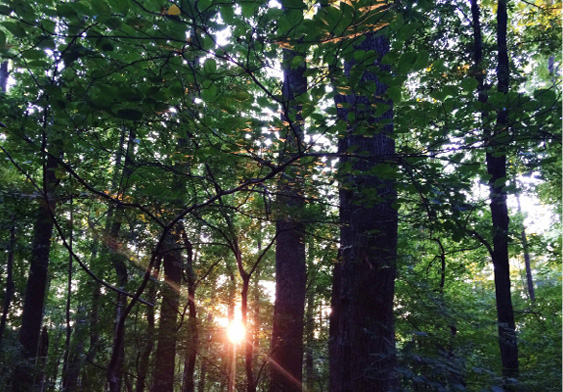
Walking downhill from 3,490 feet is rough on the knees, but I emerged from the woods at about 12:30 p.m. I spotted a couple in the distance looking at a stream, the first people I’d seen in 27 hours. I heard the growl of motorcycles and saw a stream of Harley-Davidsons zooming around the last bend of the Tail of the Dragon.
We all pull different things from inside a mountain, I suppose.
I got into the truck at 12:58 p.m., tossed the 911 paper to the floorboard, and headed out of the woods and toward my leafy neighborhood.
***
A few weeks later, I’m sitting on my comfortable porch with the swallows and blackbirds, and I’m reading a magazine story that says every fourth-grader in America now gets free access to national parks. It’s an attempt to attract the next generation of hikers, to fight a trend that shows younger people aren’t using the parks anymore.
I don’t know why that is or how to reverse the trend. But I know there was another story in the magazine about a man named Kerry Gallivan, who co-founded Chimani, which is, according to the magazine, “basically a guidebook—curated original content—in an app that’s designed for when there’s no connectivity.”
Gallivan says devices like his will be the key to the future of hiking. People need positive experiences in parks, he says. “We want to make sure that when you go to a park, you walk away feeling like it’s 10 times better than Disneyland.”
The app is capitalizing on something humans will always want: the comfort of information. If we’ve proved anything, it’s that we’ll consume it as long as people like Gallivan deliver it. It’s ingrained in us from birth: We want to know as much as we can. We want a guide.
Gallivan seems to have good intentions. But maybe in some ways he’s wrong. Maybe the parks don’t need to be more like Disneyland. Maybe what we want isn’t what we need. Maybe in the information age, there’s still a place for figuring things out on our own, for going into unfamiliar places without a manual, to get wet, to get lost. Maybe the only way to have an answer to the unknown is to face it every so often.
This article originally appeared in the September 2016 issue of SUCCESS magazine and has been updated.
The post ‘Maybe the Only Way to Have an Answer to the Unknown Is to Face It Every So Often’ appeared first on SUCCESS.
from SUCCESS https://ift.tt/9N6ute5
Comments
Post a Comment